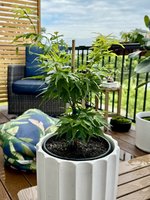turnyface
Yamadori
I received a Japanese Maple (Mikawa Yatsubusa) as a gift. The tree is young and still in a nursery pot. I'm thinking ahead to what to do over the winter.
I'm in zone 4a.
I do have an attached, unheated garage and wondering when is the best time for me to move it into the garage?
Do I wait until average low temps are in the 20s Fahrenheit before I move it into the garage?
Do I take it out when average low temps return to the 20s Fahrenheit?
I suspect it'll need to stay in the garage from early December to early March. I've done a lot of reading, but nothing definitive for my particular situation.
I'm in zone 4a.
I do have an attached, unheated garage and wondering when is the best time for me to move it into the garage?
Do I wait until average low temps are in the 20s Fahrenheit before I move it into the garage?
Do I take it out when average low temps return to the 20s Fahrenheit?
I suspect it'll need to stay in the garage from early December to early March. I've done a lot of reading, but nothing definitive for my particular situation.


